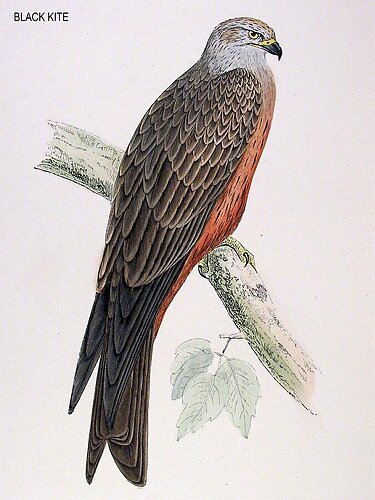BLACK KITE.
Falco migrans, BODDAERT. Falco—To cut with a bill or hook. Migrans-Migratory.
So long ago as the year 1684 a 'Black Gled' was described
by Sibbald as a then bird of Scotland; but I should think it very
doubtful if this species was the one mentioned by him under that name,
though of course it is possible that it may have been. Be that, however,
as it may, a fine adult male bird was caught the 11th. of May, 1866,
in the deer park of Alnwick Castle, Northumberland, the seat of His
Grace the Duke of that county.
This Kite is a plentiful species in various parts of the world, and
in some appears in immense numbers.
It breeds, in Europe, in Spain, Portugal, France, Greece, Switzerland,
Germany, in the southern parts; is found also in Russia, Denmark,
and has occurred in Holland. In Africa, in Morocco and Algiers, Nigritia,
and near the Cape of Good Hope, in Abyssinia, likewise in Egypt, but
in this last only, it is thought, en passant. So, too, even in Madagascar
and Japan. From the mainland it spreads eastwards to Palestine, the
Caucasus, Persia, Affghanistan, and thence, backwards, to the "cold,
bitter cold" of Siberia, and again to Turkey and other parts.
It is a migratory bird, going northwards in spring, and returning
to southern regions in autumn. Hence its specific name.
It enters towns without fear, and is welcomed for its usefulness as
a 'sanitary officer.''
Its natural haunts are forests and woods, both of higher and lower
districts.
According to M. de la Fontaine, it repairs daily at the same hour
to the waters where it uses to feed, following then the course of
the river, stopping by the way when it perceives any fish, but not
for longer than to capture what it can. It darts in after its prey
into the more shallow parts, seizing such with its claws, and taking
it to some distance to eat, after shaking the water from its feathers.
It appears that fish, frogs, and such like, form the staple of its
food, but it also takes such insects, birds, and small animals as
may come in its way, even poultry, when pressed to it. It seems, however,
to allow itself to be robbed of what it has got, by crows.
These birds breed in small companies, as well as, if so I may say,
in single pairs. The nest is stated to be very small for the size
of the builders. It is built in a tall tree, or among brushwood, or
rocks, the materials being merely sticks, lined with wool, rags, or
any other soft materials.
The eggs are said to be generally two in number, of a dull whitish
colour, with blots and spots more or less of light reddish brown or
brownish yellow, through which are sometimes seen patches of pale
pink.
The Rev. Canon H. B. Tristram says, 'This elegant and graceful bird
exhibits some amusing peculiarities in its nidification. It has a
passion for gaudily-coloured rags, which it assiduously collects and
hangs in front of and around as well as in its nest. It does not appear
to lay more than three, often only a single egg.'
Length, about one foot ten inches; bill, black, the lower one yellowish
at the base, the cere yellow; iris, pale greyish yellow, surrounded
by a black line. Crown, back of the head, and nape dull white, each
feather with a streak of dark brown, numerous on the front feathers,
but wider on the after ones, the whole having a grey appearance; chin,
throat, and breast, dull brown, each feather with a dark stripe bordered
by dull white along it; below, it is deep ferruginous with a dark
line along the shaft of each feather; back, deep brown, with a slight
tinge of purple, the feathers darker near the shafts than at the edges.
The wings underneath are tinged with rufous; the first quill feathers
are dark reddish brown, nearly black; the tertiaries also dark, or
almost black, reddish brown, but with a gloss of purple; greater wing
coverts, deep brown, with a gloss of metallic purple, the feathers
darker near the shafts and lighter along the edges. The tail underneath
is of a brownish grey colour, barred and mottled with a darker shade.
Legs, yellow; toes, yellow; claws, black.
The female is rather larger, and of a darker and more reddish colour.
The young have the iris dark, and generally the plumage more mottled,
each feather ending with a greyish white or ferruginous patch. The
bands on the tail are less distinct.
I am indebted to my friend Professor Newton for the account which
I have condensed as above.
"When the Kite builds, look to lesser linen."
A Winter's Tale.
